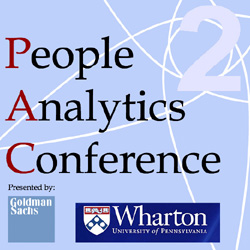The Wharton People Analytics Conference (PAC) invited teams to submit research focused on data driven approaches to managing people for the PAC Research Paper Competition held on April 10-11, 2015. The PAC, now in its second year running, was widely hailed as one of the leading people analytics conferences in the country on its debut, with participation from academia and C-level executives from companies such as Google, Goldman Sachs, and Credit Suisse.
For questions, please contact Mridul Ganesh or Aakash Gupta.
Results:
Winner
Fitting In or Standing Out? The Tradeoff between Structural and Cultural Embeddedness.
Sameer B. Srivastava, University of California, Berkeley; Amir Goldberg, Stanford University; Govind Manian, Stanford University; Will Monroe, Stanford University; Christopher Potts, Stanford.
A recurring theme in sociological research is the tradeoff between fitting in to and standing out from a social group such as a formal organization. Recent work examining this tension has privileged network structural accounts over cultural explanations. We remedy this imbalance by developing a theory of how structural and cultural embeddedness relate to individual attainment. Given that organizational culture is hard to observe, we develop a novel approach to assessing an individual’s cultural fit with an organization based on the language expressed in internal email communications. Drawing on a unique data set that includes the complete corpus of 10.25 million email messages exchanged over five years among 601 employees in a high-technology firm, we find that network constraint impedes, and cultural fit promotes, attainment. We also find evidence of a tradeoff between the two forms of embeddedness: cultural fit benefits individuals with low network constraint (i.e., brokers) but hurts those who are highly constrained.
First runner up
Discretion in Hiring.
Mitchell Hoffman, University of Toronto; Lisa Kahn, Yale; and Danielle Li, Harvard.
Second runner up
Do Good Promotion Tournaments Make Bad Managers? Evidence of the "Peter Principle" in Sales.
Alan Benson, University of Minnesota; Danielle Lie, Harvard Business School; Kelly Shue, Chicago Booth.
Firms use employment promotions both as an incentive and for matching. However, these goals may conflict; the best salesperson may not make the best sales manager. We estimate the costs of managerial mismatch using data from 244 companies subscribe to hosted sales performance mangement software. Consistent with tournament theory, firms promote strongly based on raw sales performance. However, consistent with the Peter Principle, firms deemphasize observable prepromotion characteristics correlated with subsequent managerial performance. When top salespeople and top predicted managers differ, when promoted, the median of the former underperforms the latter by one-third of a standard deviation.
Honorable Mention
Internal Markets, Personal Networks, and Human Resource Allocation: How Managers Create Value through Internal Hiring.
JR Keller, The Wharton School, University of Pennsylvania.
Internal hiring matches current employees to new jobs within an organization and represents a critical yet overlooked source of value creation, enabling managers to generate greater value from their existing stock of human resources by creating complementary matches between people and jobs. Yet despite the fact that more than half of all jobs are filled internally, our knowledge of how workers are allocated to jobs within organizations remains grounded in work on bureaucratic internal labor markets and intra-organizational careers describing internal labor markets that bear little resemblance to their contemporary counterparts. In this paper, I describe the effects of two processes that have emerged to replace the use of bureaucratic rules for facilitating internal mobility – market-oriented posting and relationship-oriented sponsorship – on two sets of outcomes which link directly to value creation and value capture – quality of hire and compensation.
Drawing on the literatures related to organizational search and decision-making, I argue that an internal market is superior to a manager’s personal network in helping to avoid errors associated with bounded awareness, a phenomenon in which cognitive blinders prevent a manager from searching for, recognizing and using relevant and accessible information during the decision-making process. Specifically, the formality and open competition of the posting process will encourage managers to seek out information that allows them to better evaluate the fit between candidate qualifications and requirements of the job while limiting the use of irrelevant information that may lead poor hiring decisions. Posting will also generate alternatives residing outside a manager’s informal network, reducing the likelihood an exceptional internal candidate will be overlooked. Turning to recent work recent work exploring the social psychological aspects of negotiation, I then argue that employees hired through posting will receive a higher starting salary for the same job, as they are less likely to adopt a relational orientation to salary negotiation and therefore more likely to both initiate salary negotiations and adopt a competitive approach when negotiating.
I test these predictions using data on over 11,000 internal hires made over a five year period within a Fortune 50 company, complemented by data on more than 350,000 combined internal and external job applications. The results suggest that the market-oriented posting process benefits both firms and workers. Candidates hired through posting have higher performance ratings in the first year on the job, are more likely to be ranked in the top quartile of their peer group and less likely to be ranked in the bottom half of their peer group, and are less likely to exit the firm within a year, creating significant value for the firm. At the same time, posting enable workers to capture more value through higher salaries, as workers hired through posting receive starting salaries 4%-8% higher than sponsored candidates hired into in equivalent jobs. In addition to providing a more complete picture of hiring and mobility, this work sheds light on the tradeoffs associated with the use of markets and networks for allocating other strategic resources within firms.
Honorable Mention
How corporate social responsibility reduces employee turnover: Evidence from attorneys before and after 9/11.
Daniel M. Olson, University of Maryland, College Park; Seth Carnahan, University of Michigan; David Kryscynski, Brigham Young University.
Mortality-related shocks, such as the death of loved ones or a tragedy like the terrorist attacks of 9/11, may cause individuals to desire greater pro-social impact in their lives — i.e. they may search for more of "the experience of helping others" (Grant & Sonnentag, 2010: 13). As part of this search, they may reevaluate their careers (Jonas, Schimel, Greenberg, & Pyszczynski, 2002; Landau et al., 2004), potentially quitting their jobs if they do not feel they have sufficient opportunities to help others (Grant & Wade-Benzoni, 2009). An employee’s departure removes valuable human capital from the firm, disrupts organizational routines, and potentially leads to lower firm performance. Firms that are better able to retain their employees following such shocks may be better positioned to realize human capital-based competitive advantages (Campbell, Coff, & Kryscynski, 2012; Chadwick & Dabu, 2009; Coff, 1997). Scholars have little understanding how organizations can prevent the departure of these employees. We argue that investments in Corporate Social Responsibility (CSR) initiatives— "discretionary corporate activit[ies] intended to further social welfare" (Barnett, 2007)—may buffer firms against unwanted employee departures after mortality-related shocks by satisfying employees’ desires for pro-social impact.
We examine our propositions using nationwide data from the Martindale-Hubbell directory of lawyers on the careers of attorneys employed by large US law firms from 1999 to 2010. We utilize the 9/11 terror attacks as a tragic shock; constructing a treatment group of attorneys born in New York City (NYC) and a control group of their officemates. We focus on individuals working outside of NYC to better isolate psychological rather than economic effects and we find that NYC-born lawyers are approximately 30% more likely than their officemates to leave the legal services industry in 2002. We then examine the moderating effect on turnover of the law firm’s investments in pro bono legal services, a common form of CSR investments in the industry (Burbano, Mamer, & Snyder, 2013), and find that the impact of 9/11 on the turnover of NYC-born attorneys is substantially attenuated in firms with larger investments in pro bono. Robustness tests and qualitative interviews support our argument that the opportunity for pro-social impact provided by CSR investments is a primary mechanism underlying the observed reduction in turnover.
We contribute to research on the impact of CSR investments on employee-related outcomes (Bode, Singh, & Rogan, 2014; Flammer & Luo, 2014; Gubler, Larkin, & Pierce, 2014) by suggesting that CSR investments may prevent employees from negatively evaluating their jobs following mortality-related shocks. Our work also suggests that the insurance-like properties of CSR investments (Godfrey, Merrill, & Hansen, 2009; Godfrey, 2005; Koh, Qian, & Wang, 2014; Minor & Morgan, 2011; Schnietz & Epstein, 2005) extend to negative employee outcomes and to shocks that cannot be attributed to the firm. We further suggest that employee perceptions of the pro-social impact of their jobs may be subject to time compression diseconomies (Dierickx & Cool, 1989), implying that firm investments in CSR need to occur well before mortality-related shocks. Many of the firm’s employee-related investments, such as training and compensation, can be viewed through the lens of time compression diseconomies. Thus, our study raises the intriguing notion that the timing, as well as the content, of employee inducements such as CSR investments may be important for retaining employees and achieving human capital-based competitive advantages.
Honorable Mention
Toxic Workers.
Dylan Minor, Kellogg School of Management, Northwestern University; Michael Housman, Cornerstone OnDemand.
There is an abundance of work exploring how to find, develop, and incentivize top performers to enhance organizational performance. While this is important, it is also important to consider a less studied area: avoiding workers who are harmful to an organization's culture and performance. These workers could simply be a bad fit, leading to premature termination and a costly search for and training of a new worker. However, even worse is a worker who harms the organization itself, whom we refer to as a toxic worker. This type of worker engages in sexual harassment, workplace violence, or some other breach of important company policy or law. At worst, such workers can cost a firm billions of dollars, as evidenced by the example of JP Morgan's so-called "London Whale" incident with Bruno Iksil.
The origins of worker misconduct are varied. There is consistent evidence that incentives can at least nudge workers to create adverse outcomes. There is also evidence that a worker's personal characteristics are important in determining her ethical behavior. Thus, one approach to managing toxic workers—and the approach we focus on in this paper—is simply avoiding them. By exploring the actual conduct and characteristics of over 50,000 workers across time and different organizations and applying a variety of analytic methods, we identify several predictors of toxic workers: overconfidence, poor job fit, and self-proclaimed rule followers. And these predictors can be identified before a worker is hired for the position.
Much of the past work on worker ethics and misconduct has been based on surveys, self-reports, and intention-based outcomes. The mixed results of this past work likely stem from the challenge of empirically examining subjective data. Very few employees are up-front about their intent to engage in misconduct. Our paper complements this important work by linking personal characteristics with objective conduct outcomes across a very large sample. Further, to identify our estimates we take advantage of the fact that, in our setting, a worker’s first placement is essentially random.
In addition to a worker's personal characteristics, we find evidence that a worker's work environment (i.e., his particular location within a firm) contributes to the likelihood of him becoming a toxic worker. Consequently, we are able to compare the relative importance of an individual's characteristics to her environment in creating toxic workers.
We also identify and measure second-order effects of toxic workers on an organization. In particular, we find that such workers increase the likelihood that other workers will also become toxic. It does appear as though one bad apple can spoil the bunch. Interestingly, toxic workers exhibit an above-average quantity level of performance. Thus, we find that there is a potential trade-off of employing an unethical person: on one dimension they excel and on another dimension they are corrupt. However, we also find that toxic workers produce subpar quality of work. We then compare toxic workers with "superstar" workers and find that removing the former has a greater organizational productivity impact than adding the latter.
Rights and Permissions
All authors retain ownership rights to the research and the right to publish the research after the conference. Upon submission, authors grant access to The Wharton School to make their research available for public viewing online and for conference use for the Wharton People Analytics Conference.
Authors are responsible for obtaining permission from third parties to reprint copyrighted information such as data, tables, or figures that may be protected by copyright.



